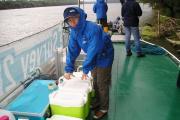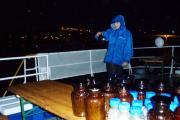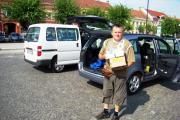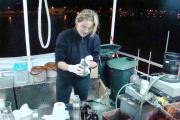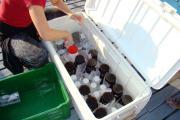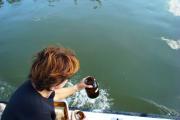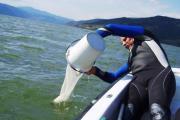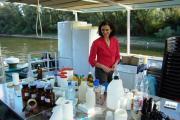
Almost every day, that means hundreds of sampling vessels, all of which are thoroughly pre-cleaned, filled, labelled, stored, cooled in portable fridge-coolers and eventually sent to labs throughout Europe. It's a highly time-consuming and rather routine business. On many days, because conditions often hamper an early finish to actual sampling, the processing of the containers is done late at night. On many nights, the team only finishes putting away the containers around midnight or early in the morning. Often, they are struggling against fatigue outside on deck in dark, cold, rainy, wavy and slippery conditions. On top of that, the National Teams of scientists often bring loads of extra samples that they have collected from the tributaries in their countries - and these also need to be processed on the Argus.
The refrigeration units on board the ship can only cool the samples for so long. So every three or four days, the samples need to be removed from the ship and transferred in portable fridges to the JDS2 car, for transport to JDS2 labs in four countries. At times, the JDS2 car, a big Toyota, has had nearly every square centimetre used up for holding driver and samples. And at some locations where the ship could not be properly docked to the Danube shore, unloading boxes became a dangerous activity.
The JDS2 driver, Slovak retired mine technician Marian Kerestes, then needs to get to the labs before the samples cool down in the car - cooling inserts in the portable fridges basically stop working after 24 hours. Furthermore, some labs only do sample testing at special times of the week or day, which places additional burdens on the driver to meet tough time schedules. Keresztes once even slept in the car in front of a lab to be on time!
Special thanks all around go to Keresztes. Besides all of his work during the survey, he was already helping out with the transport of supplies well before the survey started. And when some sampling equipment broke down in Hungary, it was he who raced back to Bratislava to pick up new ones, and get back to the team the next day. And that's just a couple of examples of his extra work.
Some samples have also been sent by mail delivery to the labs. At one location, the JDS2 arranged a shipment of 70 kg to be shipped via DHL to the lab of the European Commission Joint Research Centre in Ispra, Italy for testing. While the cost of shipping was in the hundreds of Euros, it was worth it - as the cost to analyze the samples can be in the thousands to tens of thousands of Euros at the lab. Samples to Ispra Italy are sent once a week.
So it's important to get the samples to the labs quick. And the JDS2 team, crew and driver are doing everything in their physical and mental powers to make it happen, on time.












